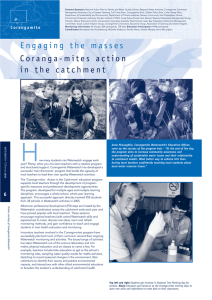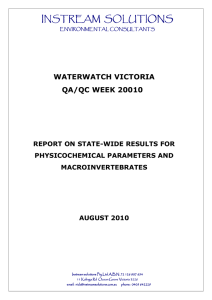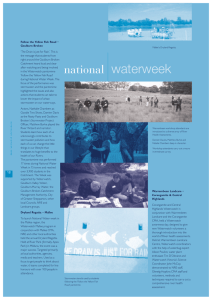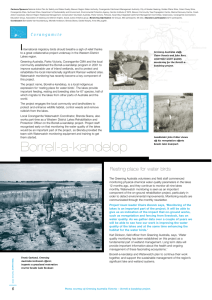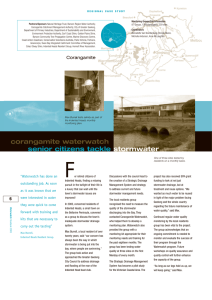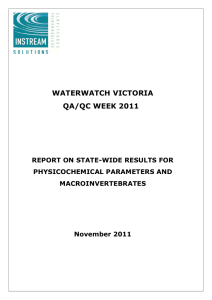INSTREAM SOLUTIONS WATERWATCH VICTORIA QA/QC WEEK 2008
advertisement
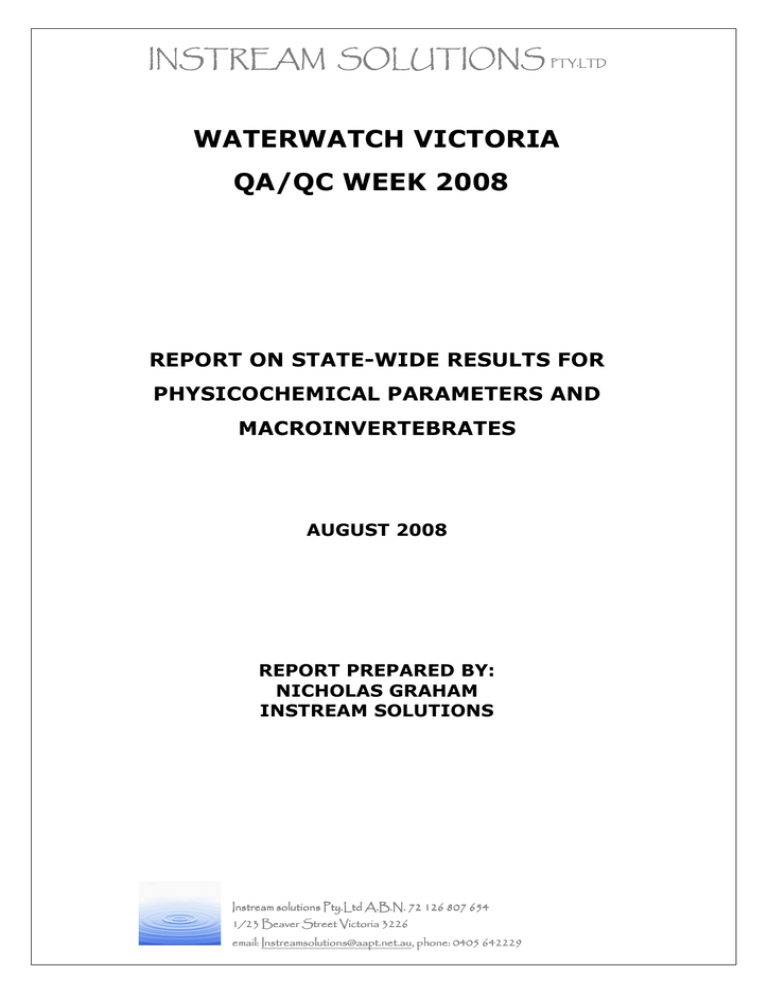
INSTREAM SOLUTIONS PTY.LTD WATERWATCH VICTORIA QA/QC WEEK 2008 REPORT ON STATE-WIDE RESULTS FOR PHYSICOCHEMICAL PARAMETERS AND MACROINVERTEBRATES AUGUST 2008 REPORT PREPARED BY: NICHOLAS GRAHAM INSTREAM SOLUTIONS Instream solutions Pty.Ltd A.B.N. 72 126 807 654 1/23 Beaver Street Victoria 3226 email: Instreamsolutions@aapt.net.au, Instreamsolutions@aapt.net.au, phone: 0405 642229 0 1.0 Background Waterwatch Victoria is a state-wide community based water quality monitoring organisation that aims to increase local community understanding and ownership of waterway and catchment issues. Community volunteers and Waterwatch coordinators are involved in the monitoring of waterway health including water quality and macroinvertebrate indicators. Waterwatch Victoria’s QA/QC Week program is an annual event co-ordinated at a state-wide level. It involves the testing of laboratory prepared standard samples by monitors and co-ordinators to ensure that their equipment and monitoring techniques are accurate. For more information on Waterwatch Victoria’s Data Confidence Framework, guidelines and data confidence plans, visit www.vic.waterwatch.org.au This report provides a simple summary of the state-wide data provided by both co-ordinators and monitors during QA/QC Week 2008. It follows on from similar programs that have been conducted annually since 1998. Further detail can be found within the ten regional reports that have been distributed to the coordinators. 2.0 Methods 2.1 Physicochemical Parameters Stable ‘Mystery’ reference water samples were prepared for pH, electrical conductivity (EC), turbidity and orthophosphate by Australian Chemical Reagents (Roach Analysts), QLD. Each parameter was further divided into a low range sample (A) and a high range sample (B) giving a total of 8 unique samples. A subset of all of these samples (approximately 10%) were tested by the NATA accredited Marine and Freshwater Research Laboratories (MAFRL), WA, to check sample homogeneity and stability. Physicochemical mystery solutions were prepared to specifications recommended by the state Waterwatch Victoria office. Values listed in Table 1 are the averaged solution concentrations of the subset measured during QA/QC Week by MAFRL. Individual parameter solutions were provided to all regions in separate bottles with labelled instructions for sample preservation and use. Acceptable upper and lower quality control limits for each parameter were set according to the standards outlined in the Waterwatch Victoria Data Confidence Framework. These quality control limits are sensitive to the wide array of equipment used by Waterwatch coordinators and monitors. Individual parameter solutions were provided to all participants in separate bottles with labelled instructions for sample preservation and use. 1 Table 1. True values and acceptable limits for phys-chem parameters. Parameter pH (pH units) EC (µS/cm) Turbidity Meter (NTU) Turbidity Tube (NTU) Orthophosphate mg/L Sample Acceptable Range True Value Lower Limit Upper Limit A ± 0.3 6.7 6.4 7 B ± 0.3 8.2 7.9 8.5 A ± 10% 580 522 638 B ± 10% 4800 4320 5280 A ± 20% 32 25 38 B ± 20% 120 96 144 A ± 25% 32 24 40 B ± 25% 120 90 150 A ± 20% 0.05 0.04 0.06 B ± 20% 0.3 0.24 0.36 A total of 1457 phys-chem samples were sent out across the state for QA/QC Week 2008. A total of 411 participants took part in QA/QC Week 2008 including 30 co-ordinators and 381 monitors. Please note that not every participant attempted all eight samples. Regional co-ordinators decided which samples they and their monitors would assess prior to QA/QC Week 2008. The minimum number of samples assessed by any one participant was two with the majority assessing between four and seven. All participants were provided with QA/QC Codes (numbers, some with letter suffixes) to allow their results to be included in the state-wide analysis anonymously. The Victorian Waterwatch Data Confidence Framework sets out minimum requirements for equipment to be used by monitors and co-ordinators to conduct water quality analysis. A summary of the requirements for monitoring standards three and four is provided in Table 2 below. Table 2. Minimum requirements outlined in the Data Confidence Framework. Parameter Standard 3 Standard 4 EC Low range = minimum resolution of 0.10 mS/cm High Range = minimum resolution of 10 mS/cm Low range = min resolution of 0.10 mS/cm High Range = minimum resolution of 10 mS/cm pH pH meters (not strips) pH meters (not strips) Turbidity Turbidity tubes Turbidity meter P04 Comparator Colorimeter 2 2.2 Macroinvertebrates A total of 73 ‘Mystery’ macroinvertebrate samples of known taxonomic composition were prepared by Instream Solutions (Victoria). These samples were provided to test the co-ordinator’s and monitor’s identification skills at variable taxonomic resolutions. The ‘mystery’ samples consisted of six macroinvertebrates that are naturally found in the majority of Victorian bioregions so not to disadvantage participants (Table 3). Coordinators and monitors were asked to identify the macroinvertebrates at the Order, Family and common name level. Analysis of results was carried out at the Family level as this is the level required for the biological indices (e.g. AUSRIVAS and SIGNAL) used in the State Environment Protection Policy Waters of Victoria (SEPP WOV). A non attempt at identification was marked as a blank space in the results sheet and was ignored in the final statistical analysis. Table 3. Macroinvertebrate “Mystery Sample” taxa list. Order Family Common Name Hemiptera Notonectidae Backswimmers Coleoptera Dytiscidae Diving Beetles Trichoptera Leptoceridae Stick Caddis Diptera Simuliidae Black Fly Larvae Plecoptera Gripopterygidae Stonefly Ephemeroptera Coloburscidae Streamhorse, Mayfly 3.0 Found in Victorian Bioregions Highlands, Forest A, Forest B, Cleared Hills and Coastal plains Highlands, Forest A, Forest B, Cleared Hills and Coastal plains Highlands, Forest A, Forest B, Cleared Hills and Coastal plains Highlands, Forest A, Forest B, Cleared Hills and Coastal plains Highlands, Forest A, Forest B, Cleared Hills and Coastal plains Highlands, Forest A, Forest B, Cleared Hills and Coastal plains Results 3.1 physicochemical The following table summarises results from co-ordinators across the ten regions. Pass rates were high for three of the parameters in both low range (A) and High range (B). The exception was the orthophosphate (P04) samples where co-ordinators performed poorly across both of the ranges. As can be seen in Figure 1 co-ordinator results in 2008 were similar to 3 those observed in 2007. The only exception was orthophosphate again, where pass rates were significantly lower when compared to the previous year. Table 4. Co-ordinator pass rates for physicochemical parameters. Parameter pH (pH units) EC (µS/cm) Turbidity (NTU) Orthophosphate mg/L Sample A B A B A B A B Number of results (n) 23 22 27 22 26 19 24 11 Pass Rate % 96 86 89 96 100 85 54 18 2007 Pass Rate % 92 91 100 93 90 92 78 97 It should be stressed that the pass rates for 2007 were based on allowing error rates of greater than 20%. This year they have been set at ± 20% following the guidelines in the Waterwatch Victoria Data Confidence Framework. To achieve this level of accuracy using colour comparators, such as the Aquaquant and Visocolor, participants needed to match the colour almost exactly. A shade lighter or darker on the colour wheel would have given a result greater than 20 percent outside of the true value and thus a fail. Without this level of accuracy the data can not be used to determine rough trends in water quality. A quick analysis of the 2008 data using the 2007 acceptable error rates was conducted to make a more realistic comparison between the two years. Results for the low range samples were found to be similar while the 2008 high range results where significantly lower when compared to those of 2007. Figure 1. Comparison of Co-ordinator pass rates between 2007 and 2008. Co-ordinator comparison 2007/2008 % Pass Rate 100 90 80 70 60 50 40 2007 2008 30 20 10 0 pH A pH B EC A EC B Turb A Turb B P04 A P04 B 4 Results for the monitors are summarised in Table 5 below. Once again pass rates are generally quite high (>80%) with the exception being orthophosphate. Table 5. Monitor pass rates for physicochemical parameters. Parameter pH (pH units) EC (µS/cm) Turbidity (NTU) Orthophosphate mg/L Sample A B A B A B A B Number of results (n) 243 246 303 246 275 157 263 52 Pass Rate % 95 91 83 91 88 89 38 31 2007 Pass Rate % 90 88 91 88 83 70 73 61 The comparison between pass rates in 2007 and 2008 suggests that monitors improved their accuracy across the pH and Turbidity parameters. Results for EC A where marginally lower while results in both orthophosphate ranges were again significantly lower. (If the P04 pass limits are expanded to equal those used in 2007 then monitor results have marginally improved in 2008). Figure 2. Comparison of monitor pass rates between 2007 and 2008. Monitor comparison 2007/2008 100 90 % Pass Rate 80 70 60 2007 50 40 2008 30 20 10 0 pH A pH B EC A EC B Turb A Turb B P04 A P04 B 5 A comparison between the performance of the co-ordinators and that of the monitors, in 2008, is provided in figures 2 and 3. Across the low range (A) parameters co-ordinators achieved higher pass rates than the monitors, except for pH where they were both equal. Figure 3. Pass rates for co-ordinators and monitors – Low range Low Range Sample A 100 90 % Pass Rate 80 70 60 Co-ordinators Monitors 50 40 30 20 10 0 pH EC Turbidity P04 Through the high range parameters (B) both groups had similar pass rates with the exception been orthophosphate where the monitors actually performed better than the co-ordinators. Figure 4. Pass rates for co-ordinators and monitors – High range High Range Sample B 120 % Pass Rate 100 80 Co-ordinators Monitors 60 40 20 0 pH EC Turbidity P04 6 3.2 Macroinvertebrates 20 co-ordinators and 39 monitors attempted to identify the macroinvertebrate ‘Mystery samples’. Bugs were identified by eye, hand lens or microscope using a variety of macroinvertebrate keys and picture books. All of the co-ordinators and approximately half of the monitors attempted to identify the bugs at family level. Pass rates where generally quite good with the co-ordinators having a higher overall pass rate than the monitors. Table 6. Family level pass rates for macroinvertebrates Position Notonectidae Dytiscidae Leptoceridae Simuliidae Gripopterygidae Coloburiscidae Co-ordinators 80 75 90 95 95 70 Monitors 79 88 71 86 85 61 Table 7. Common misidentifications at family level Macroinvertebrate Common Mistakes Notonectidae Corixidae, Gyrinidae Dytiscidae Hydrophildae, Haliplidae, Elmidae Leptoceridae Helicophidae, Calamoceratidae Simuliidae Psychodidae Gripopterygidae Eusthenidae, Notonemouridae Coloburiscidae Leptophlebidae, Baetidae Identification of macroinvertebrates at family level can be difficult. There are a number of ways individual regions can improve their identification accuracy if they wish to, including; purchasing stereo microscopes, obtaining appropriate family level keys and participating in macroinvertebrate training seminars. 7 4.0 Outstanding Performers – in the field of excellence The following table is a list of all the participants who attempted six or more of the phys-chem samples and achieved a 100% pass rate. Table 8. Participants who achieved a 100% pass rate for phys-chem SAMPLES REGION CODE POSITION STANDARD MEASURED Corangamite 165 co-ordinator 3 7 Corangamite 167 co-ordinator 3 6 Corangamite 105 Monitor 3 6 Corangamite 112 Monitor 3 6 Corangamite 113 Monitor 3 6 Corangamite 114 Monitor 3 6 Corangamite 117 Monitor 3 6 Corangamite 123 Monitor 3 6 Corangamite 126 Monitor 3 6 Corangamite 128 Monitor 3 6 Corangamite 147 Monitor 3 6 Corangamite 148 Monitor 3 6 Corangamite 154 Monitor 3 6 Corangamite 162 Monitor 3 6 Corangamite 163 Monitor 3 6 East Gippsland 204 monitor 3 8 Glenelg Hopkins 422 monitor 3 8 Glenelg Hopkins 439 monitor 3 7 Glenelg Hopkins 439 monitor 3 6 Glenelg Hopkins 440 monitor 3 7 Glenelg Hopkins 441 monitor 3 6 Glenelg Hopkins 468 monitor 3 8 Goulburn broken 505 co-ordinator 4 6 Goulburn broken 595 co-ordinator 4 6 Goulburn broken 536 monitor 3 6 Goulburn broken 537 monitor 3 6 Goulburn broken 539 monitor 3 6 Goulburn broken 586 monitor 4 6 North East 810 Monitor 3 8 Port Phillip 9mp01 monitor 3 6 Port Phillip 9mp03 monitor 2 6 Port Phillip 9mp05 monitor 2 6 Port Phillip 9tg02 monitor 7 Port Phillip 9tg05 monitor 7 Port Phillip 9tg13 monitor 7 Port Phillip 9tg14 monitor 7 Wimmera 100402 monitor 3 6 Wimmera 100403 monitor 3 6 Wimmera 100404 monitor 3 6 Wimmera 100409 monitor 3 7 8 The table below lists all the participants who correctly identified the Order, Family and common names of all six macroinvertebrates. Table 9. Participants with a 100% pass rate for macroinvertebrates Region Code Position Corangamite Corangamite Corangamite Corangamite Corangamite Corangamite Corangamite Goulburn Broken Goulburn Broken Mallee Mallee Mallee North East North East PPWP PPWP PPWP Wimmera 165 166 167 117 118 121 126 511 517 601 602 616 801 802 9gw3 9jv13 9tg11 10100 co-ordinator co-ordinator co-ordinator monitor monitor monitor monitor co-ordinator monitor co-ordinator co-ordinator monitor co-ordinator co-ordinator co-ordinator monitor monitor co-ordinator 5.0 Conclusion The annual QA/QC Week, which is conducted across the state, is just one quality control check provided by Waterwatch Victoria to support volunteer monitors and co-ordinators. This year over 400 data sheets for phys-chem and 70 data sheets for macroinvertebrates were received for analysis. Pass rates for samples were generally high with the exception being the orthophosphate parameter. A comparison between the 2007 and 2008 results revealed that overall the pass rates are approximately the same for the two years. Several issues relating to the use of equipment were discovered when processing the data from QA/QC Week 2008. A number of level 3 and 4 participants were using pH strips instead of pH meters to determine this parameter. Many level 4 co-ordinators and monitors were also using turbidity tubes and colour comparators when according to the Data Framework they should have been using turbidity meters and colorimeters. It is suggested that if these participants were to use the appropriate equipment (which is more accurate when used correctly) many of their pass rates would improve. 9 Appendix 1: Data Raw data from qa/qc Week 2008 can be accessed in excel spreadsheet format upon request from Waterwatch Victoria 10
